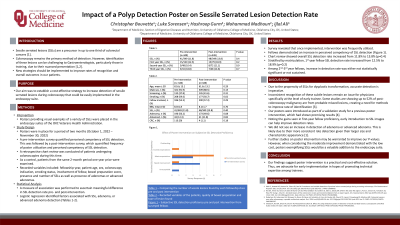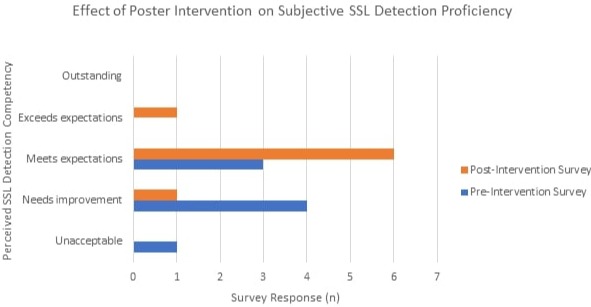Monday Poster Session
Category: General Endoscopy
P1975 - Impact of a Polyp Detection Poster on Sessile Serrated Lesion Detection Rate
Monday, October 23, 2023
10:30 AM - 4:15 PM PT
Location: Exhibit Hall

Has Audio
- CB
Christopher Bouvette, MD
University of Oklahoma College of Medicine
Oklahoma City, Oklahoma
Presenting Author(s)
Christopher Bouvette, MD, Luke Sorensen, MD, Hashroop Gurm, MD, Mohammad Madhoun, MD, Ijlal A. Ali, MD
University of Oklahoma College of Medicine, Oklahoma City, OK
Introduction: Sessile serrated lesions (SSLs) are a precursor of colorectal cancer. However, identification of these lesions is challenging to Gastroenterologists, particularly those in training, due to their nuanced presentation. To improve rates of recognition, we explored the efficacy of poster intervention on the detection of SSLs.
Methods: The study occurred at Oklahoma City Veterans Health Administration (OKC VHA). The intervention was comprised of posters displayed adjacent to monitors in procedure rooms, providing visual examples of a variety of SSLs. Posters were in place for a period of two months (Oct–Nov 30, 2022). Pre-intervention survey quantified perceived competency of SSL detection. Post-intervention survey quantified frequency of poster utilization and perceived competency of SSL detection. A retrospective chart review was conducted of patients undergoing colonoscopies during this time. As a control, patients from the same 2 month period one year prior were examined. Recorded variables: fellowship year, patient age, sex, smoking status, colonoscopy indication, bowel prep score, presence and number of SSLs, and presence of adenomas or advanced adenomas (AA). A measure of association was performed to ascertain meaningful difference in SSL detection rate pre- and post-intervention. Furthermore, logistic regression identified factors associated with SSL, adenoma, or AA detection (Table 1).
Results: Survey revealed that once implemented, intervention was frequently utilized and fellows demonstrated an increase in perceived competency of SSL detection (Figure 1). Chart review showed, SSL detection rate increased from 11.8% to 13.8% (p=0.4), stratified by matriculation, 1st year fellow SSL detection rate increased from 12.5% to 18.9% (p=0.2). Among 2nd-3rd year fellows, increase in detection rate was either not statistically significant or not sustained.
Discussion: Due to the propensity of SSLs for dysplastic transformation, accurate detection is imperative. Inconsistent recognition of these subtle lesions remains an issue for physicians. Study was a validation study in trainees of a previous poster intervention. Noting the gains seen in first-year fellow proficiency, early introduction to SSL images helps improve detection and promotes better habits than senior fellows/attendings. Our findings suggest poster intervention is a practical and cost-effective solution. Thus, we advocate for early implementation in hopes of promoting technical expertise among trainees.

Disclosures:
Christopher Bouvette, MD, Luke Sorensen, MD, Hashroop Gurm, MD, Mohammad Madhoun, MD, Ijlal A. Ali, MD. P1975 - Impact of a Polyp Detection Poster on Sessile Serrated Lesion Detection Rate, ACG 2023 Annual Scientific Meeting Abstracts. Vancouver, BC, Canada: American College of Gastroenterology.
University of Oklahoma College of Medicine, Oklahoma City, OK
Introduction: Sessile serrated lesions (SSLs) are a precursor of colorectal cancer. However, identification of these lesions is challenging to Gastroenterologists, particularly those in training, due to their nuanced presentation. To improve rates of recognition, we explored the efficacy of poster intervention on the detection of SSLs.
Methods: The study occurred at Oklahoma City Veterans Health Administration (OKC VHA). The intervention was comprised of posters displayed adjacent to monitors in procedure rooms, providing visual examples of a variety of SSLs. Posters were in place for a period of two months (Oct–Nov 30, 2022). Pre-intervention survey quantified perceived competency of SSL detection. Post-intervention survey quantified frequency of poster utilization and perceived competency of SSL detection. A retrospective chart review was conducted of patients undergoing colonoscopies during this time. As a control, patients from the same 2 month period one year prior were examined. Recorded variables: fellowship year, patient age, sex, smoking status, colonoscopy indication, bowel prep score, presence and number of SSLs, and presence of adenomas or advanced adenomas (AA). A measure of association was performed to ascertain meaningful difference in SSL detection rate pre- and post-intervention. Furthermore, logistic regression identified factors associated with SSL, adenoma, or AA detection (Table 1).
Results: Survey revealed that once implemented, intervention was frequently utilized and fellows demonstrated an increase in perceived competency of SSL detection (Figure 1). Chart review showed, SSL detection rate increased from 11.8% to 13.8% (p=0.4), stratified by matriculation, 1st year fellow SSL detection rate increased from 12.5% to 18.9% (p=0.2). Among 2nd-3rd year fellows, increase in detection rate was either not statistically significant or not sustained.
Discussion: Due to the propensity of SSLs for dysplastic transformation, accurate detection is imperative. Inconsistent recognition of these subtle lesions remains an issue for physicians. Study was a validation study in trainees of a previous poster intervention. Noting the gains seen in first-year fellow proficiency, early introduction to SSL images helps improve detection and promotes better habits than senior fellows/attendings. Our findings suggest poster intervention is a practical and cost-effective solution. Thus, we advocate for early implementation in hopes of promoting technical expertise among trainees.

Figure: Figure 1.
Disclosures:
Christopher Bouvette indicated no relevant financial relationships.
Luke Sorensen indicated no relevant financial relationships.
Hashroop Gurm indicated no relevant financial relationships.
Mohammad Madhoun indicated no relevant financial relationships.
Ijlal Ali indicated no relevant financial relationships.
Christopher Bouvette, MD, Luke Sorensen, MD, Hashroop Gurm, MD, Mohammad Madhoun, MD, Ijlal A. Ali, MD. P1975 - Impact of a Polyp Detection Poster on Sessile Serrated Lesion Detection Rate, ACG 2023 Annual Scientific Meeting Abstracts. Vancouver, BC, Canada: American College of Gastroenterology.
